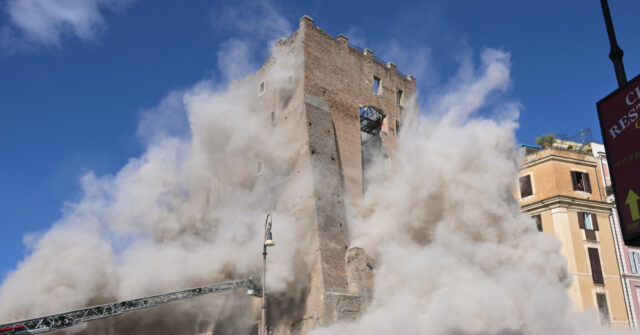Several of the upper floors of the Torre dei Conti, a High Middle Ages fortification commissioned by Pope Innocent III in 1203 for his noble family collapsed on Monday, burying workers engaged on the restoration of the building.
Several workers were rescued by fire brigades using ladder engines, but some workers were more seriously injured. One man is reported to be seriously injured, while another, a Romanian builder, was killed. Trapped under the rubble for 11 hours, rescuers dug down to the man and rushed him to hospital, but he was declared dead after resuscitation efforts failed.
The Romanian Ministry of Foreign Affairs thanked the Roman emergency services for working “tirelessly” to attempt to save the man, and noted a second Romanian was among the others who were rescued successfully. They said in a statement: “Despite the sustained efforts of the medical teams in Rome, Octav Stroici, who had been trapped under the rubble of a historic building undergoing restoration works, has sadly passed away.”
Rome prosecutors have launched an investigation into the cause of the collapse and potential crimes including “negligent disaster”, manslaughter, and causing serious injury.
The Torre dei Conti was originally 165 feet high when built in the 13th century and part of the Italian medieval fashion for great families to build fortified urban towers for protection and to express their standing in society. The oldest parts of the core of the building date back to the 9th century and themselves stand on the remains of an ancient Roman temple. The tower as it was until Monday was much shorter, standing at 95 feet, after the top parts were either destroyed or removed because of earthquakes in the early modern era.
The building remains largely standing today but with considerable interior damage.
Italy’s Il Giornale newspaper notes the building had previously contained government offices but has been abandoned for some 20 years, and in that time had fallen into disrepair with water damage and invasive plant roots damaging the fabric of the building. A report states heavy rainfall in the past few days, and a small earthquake the day before the collapse, both of which it hypothesises could be contributory factors.
Another major consideration is, of course, the fact the building has been undergoing months-long European Union-funded restoration project. While this was intended to secure the long-term future of the tower, restoration efforts are something of a moment of maximum danger for historic buildings. Paris’ Notre Dame Cathedral and Copenhagen’s Old Stock Exchange were both destroyed by fire this decade as a result of restoration works sparking blazes.
Breitbart News
Read the full article .


